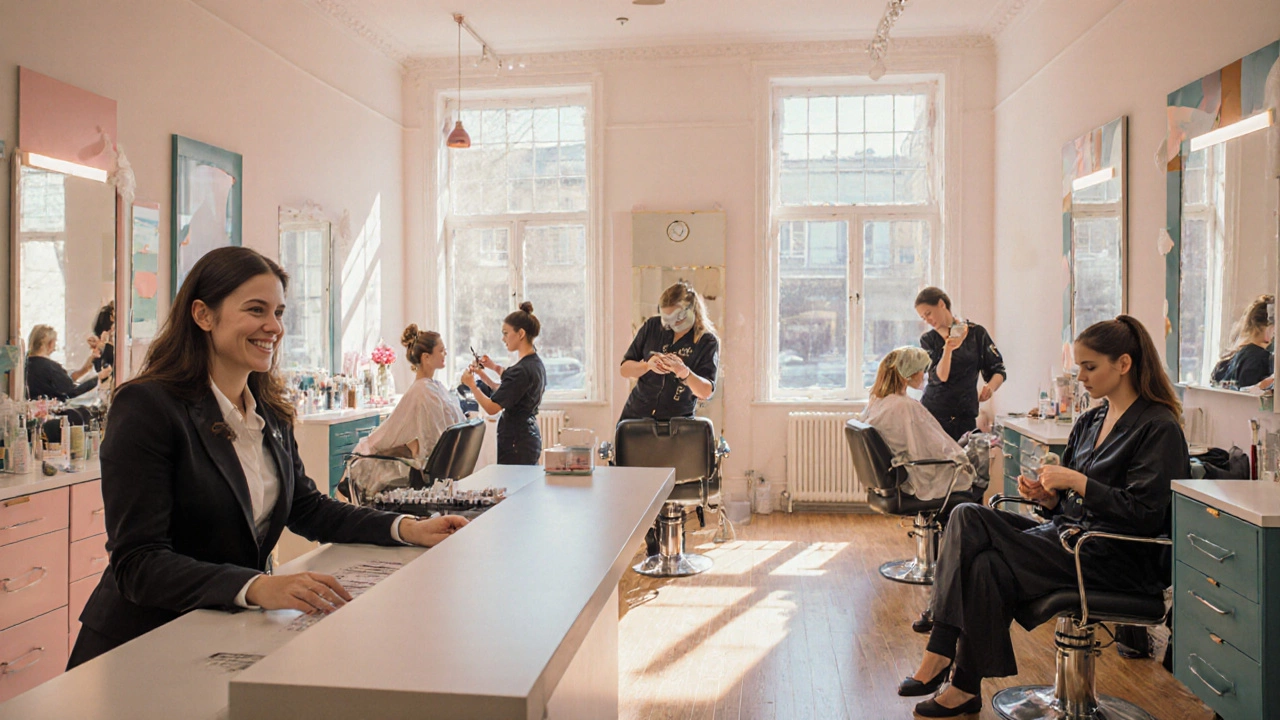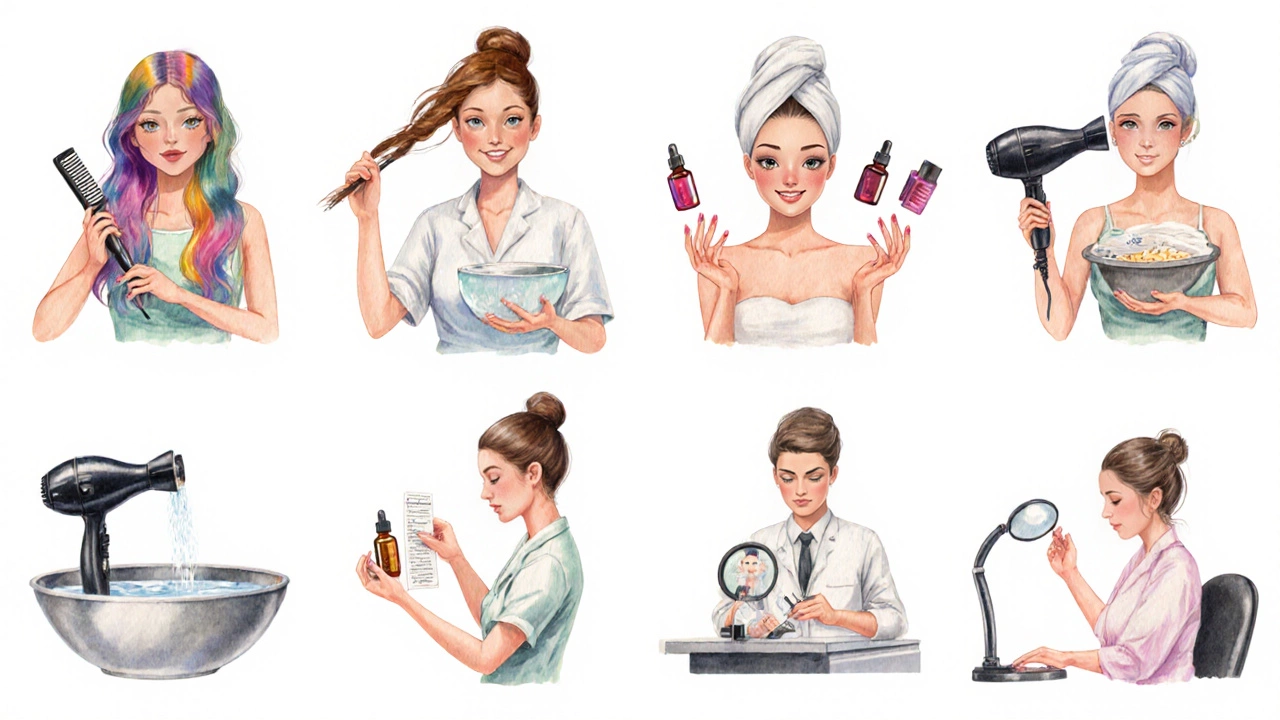
Salon Job Title Calculator
Find Your Professional Salon Title
Select your skills, experience level, and location to determine the most appropriate professional job title for your resume or LinkedIn profile.
When you walk into a buzzing beauty salon, the staff you see-stylists, assistants, receptionists-aren’t just there to fill chairs. They each carry a specific job title, and many people wonder: salon girl name is more than a slang phrase, it’s a collection of professional roles with distinct duties and training. Below we break down the most common titles, explain how they differ across regions, and give you the language you need for a résumé, a job interview, or a casual conversation.
What a "Salon Girl" Actually Refers To
Salon Girl is a colloquial umbrella term for any female employee working in a beauty salon, ranging from front‑desk staff to licensed hair professionals. While the phrase itself isn’t used in official job postings, it captures the everyday experience of customers who interact with a variety of specialists under one roof.
Core Salon Roles and Their Official Names
Below are the titles you’ll encounter most often, each introduced with schema markup so search engines can recognize them as distinct entities.
- Hairdresser - A licensed professional who cuts, colours, and styles hair. In New Zealand, a hairdresser typically holds a Level 3 Certificate in Hairdressing.
- Beautician - Provides a broader suite of services, such as facials, waxing, and basic nail work. Beauticians often complete a Certificate in Beauty Therapy.
- Cosmetologist - A more advanced credential that combines hair, skin, and nail training. In the U.S., a state‑approved cosmetology license is required.
- Hair Stylist - Focuses primarily on creative styling, up‑dos, and runway looks. Often works freelance or within high‑end salons.
- Salon Assistant - Supports senior staff by washing hair, maintaining workstation cleanliness, and handling client prep.
- Beauty Therapist - Specialises in therapeutic treatments like micro‑needling, chemical peels, and specialised skincare regimens.
- Receptionist - Manages bookings, greets clients, and often handles sales of retail products.
- Esthetician - Focuses on skin analysis, facial treatments, and advice on home‑care routines. In NZ, they may be known as skin therapists.
Comparing the Titles: Duties, Training, and Pay
| Title | Typical Duties | Required Certification (NZ) | Average Salary (NZ $ per hour) |
|---|---|---|---|
| Hairdresser | Cutting, colouring, styling, client consultation | Level 3 Hairdressing Certificate | 20-25 |
| Beautician | Facials, waxing, basic nail services, product advice | Certificate in Beauty Therapy | 18-23 |
| Cosmetologist | Full‑service hair, skin, nail treatments | Cosmetology License (US) / Equivalent NZ qualification | 22-28 |
| Hair Stylist | Creative up‑dos, event styling, trend forecasting | Often on‑the‑job training; optional advanced courses | 24-30 |
| Salon Assistant | Shampooing, station set‑up, tool sterilisation | No formal certification required | 15-18 |
| Beauty Therapist | Advanced skin treatments, client skin analysis | Advanced Beauty Therapy Certificate | 26-35 |
| Receptionist | Appointment scheduling, client intake, retail sales | Customer service training; optional admin qualifications | 16-20 |
| Esthetician | Skin assessments, facial procedures, product recommendations | Certificate in Esthetics or equivalent | 23-30 |

Why the Same Role Has Different Names Around the World
In the United Kingdom, you’ll more often hear “hairdresser” and “beautician”. In the United States, “cosmetologist” is the umbrella licence that covers all three streams. New Zealand’s terminology leans toward “hairdresser” for cut‑and‑style work and “beauty therapist” for skin‑focused services. The regional differences matter when you’re looking at job ads or writing a CV that will travel overseas.
Choosing the Right Title for Your Resume or LinkedIn Profile
- Identify the core services you performed most often. If you cut and colour hair daily, list “Hairdresser”.
- Match your formal qualifications. A Level 3 Certificate qualifies you as a “Hairdresser”, while a Beauty Therapy Certificate lets you call yourself a “Beautician”.
- Consider the employer’s language. If the salon advertises “stylists”, use “Hair Stylist” to align with their branding.
- Highlight any specialised training (e.g., “Advanced Esthetician”). This signals higher expertise and can command better pay.
Using the correct title avoids confusion, helps applicant‑tracking systems (ATS) find your profile, and shows you respect industry standards.

Common Misconceptions About the "Salon Girl" Label
- It’s not a formal job title. The phrase is slang; professionals prefer their certified titles.
- All female salon staff are called "girls". Modern workplaces use gender‑neutral language-hairdresser, stylist, therapist.
- Experience equals a higher title automatically. You need the right credentials and sometimes a formal promotion to move from assistant to hairdresser.
Quick Takeaways
- The umbrella slang "salon girl" covers hairdressers, beauticians, cosmetologists, stylists, assistants, therapists, receptionists, and estheticians.
- Certification requirements vary by role and country; in NZ, Level 3 Hairdressing and Beauty Therapy certificates are the baseline.
- When applying for jobs, match your listed title to the duties and qualifications the employer expects.
- Use gender‑neutral, industry‑standard terms on CVs and LinkedIn to improve searchability.
- Salary ranges differ: assistants start around $15/hr, while specialised therapists can earn $35/hr or more.
Frequently Asked Questions
Is "salon girl" an official job title?
No. It’s a colloquial phrase that loosely groups several licensed roles such as hairdresser, beautician, or salon assistant.
What qualifications do I need to become a hairdresser in New Zealand?
A Level 3 Certificate in Hairdressing is the standard entry qualification. Apprenticeships or on‑the‑job training can supplement classroom learning.
Can a salon assistant become a cosmetologist?
Yes. Many assistants use the role as a stepping stone, enrolling in a full cosmetology program that covers hair, skin, and nails.
Do male staff have a different title?
The titles are gender‑neutral. A male who cuts hair is still a hairdresser; a male who does skin work is a beauty therapist or esthetician.
Which title carries the highest earning potential?
Specialised roles like Beauty Therapist or Esthetician, especially those with advanced certifications, tend to command the highest hourly rates.
Whether you’re job‑hunting, updating your LinkedIn, or just curious about industry lingo, knowing the exact names and requirements behind the "salon girl" label helps you speak the language of beauty professionals and opens doors to better opportunities.